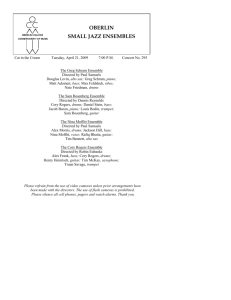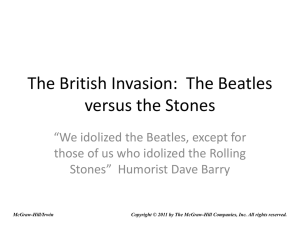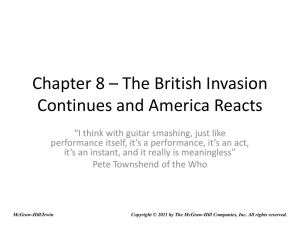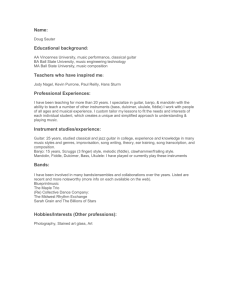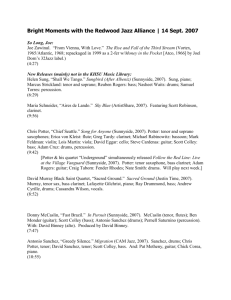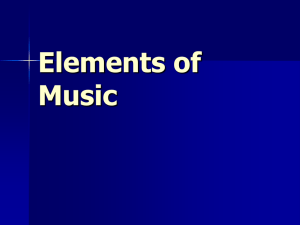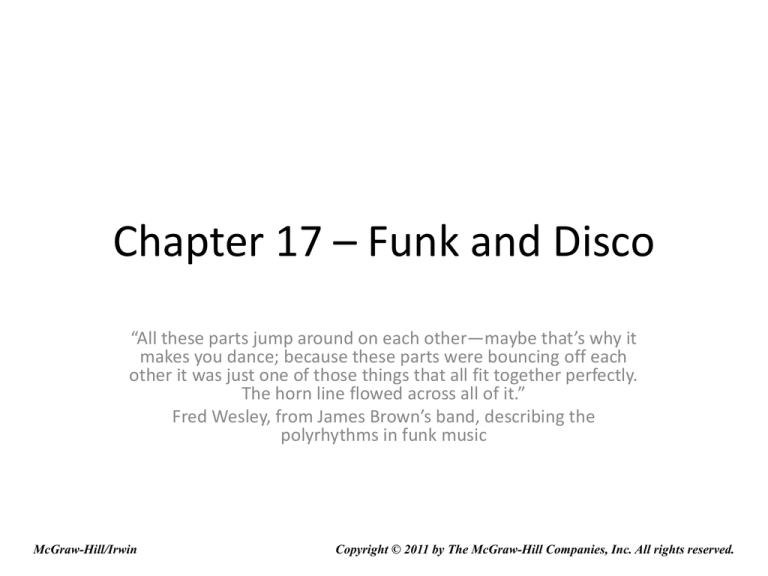
Chapter 17 – Funk and Disco
“All these parts jump around on each other—maybe that’s why it
makes you dance; because these parts were bouncing off each
other it was just one of those things that all fit together perfectly.
The horn line flowed across all of it.”
Fred Wesley, from James Brown’s band, describing the
polyrhythms in funk music
McGraw-Hill/Irwin
Copyright © 2011 by The McGraw-Hill Companies, Inc. All rights reserved.
Funk
Invented by James Brown in 1964, based on African
polyrhythms, but not as complex as those found in Africa
The first funk recording was Brown’s “Out of Sight,” the first
big hit in a funk style was Brown’s “Papa’s Got a Brand New
Bag” (1965)
Brown’s polyrhythms usually have the drums play evenly
subdivided beats, with a syncopated bass line that counters
those rhythms, and a horn section that is separate from the
drums and bass
Funk groups commonly have electric guitar, electric bass
guitar, sometimes a keyboard, a horn section, and drums
Other performers further advanced the polyrhythmic funk
style, including Sly and the Family Stone in 1970
17-2
Listening Guide
“Papa’s Got a Brand New Bag” by James Brown (1965)
Tempo: 126 beats per minute, 4 beats per bar
Form: 12-bar blues
Features: Even subdivisions, except that Brown’s vocals sometimes
relax into uneven subdivisions
The guitar accents the backbeats
Even sixteenth-note subdivisions strummed on guitar add energy at
the end of each chorus (except the last)
Polyrhythms are created among the horns, the bass, and the
drums, each of which maintains its own simple and repetitious
rhythm pattern that is different from the others
Lyrics: Papa’s “bag” is dancing
Charts: Pop, #8, R&B, #1 for eight weeks, British hits, #25s
17-3
Listening Guide
“Thank You (Falettinme Be Mice Elf Agin)” by Sly and the Family Stone
(1970)
Tempo: 108 beats per minute, 4 beats per bar
Form: Mostly 8-bar sections, with one 4-bar instrumental section
Features: Each instrument repeats its own rhythmic patterns
Polyrhythms created between the separate patterns of the electric
guitar, bass, and drums
Even beat subdivisions
Lyrics: Street fights and violence and efforts on the part of the singer
to avoid those problems and “be himself” through family unity and
music
Charts: Pop, #2 for two weeks, R&B, #1 for five weeks
17-4
Chicago Soul and Curis Mayfield
Chicago Soul of the sixties tended to have a
smooth rhythmic flow with doo-wop
influenced vocals, the Impressions
Curtis Mayfield sang lead with the Impressions,
then wrote, sang, and produced music in a
funk style for the blaxploitation” (black
exploitation) film Superfly (1972), about the
drug subculture in a black urban ghetto
17-5
Listening Guide
“Freddie’s Dead” by Curtis Mayfield (1972)
Tempo: 92 beats per minute, 4 beats per bar
Form: Recording begins with a 7-bar instrumental introduction, then sections that
vary in length from 8, 12, 16, to 20 bars
Features: Instrumentation – voice, guitar, funky syncopated electric bass guitar,
drums, other percussion, and an orchestra
Introduction comprised of a 2-bar bass and guitar riff played three times, followed
by 1-bar of solo drums
The refrain is sung five times through, with some variations in the text. The third
refrain references Freddie’s death, and the fourth warns the listener might die too
Drums play even beat subdivisions, but the bass plays the riff more freely around
the drums, creating a funky sense of rhythmic freedom
The orchestra enters at the first verse about Freddie’s death
A flute joins the bass and guitar on the riff toward the end of the recording
Between the fourth and fifth verses, the bass, guitar, and drums play a 16-bar
vamp with a repeated riff
Lyrics: Freddie was a low-level cocaine dealer and addict in the movie Superfly who is
killed by a car. Freddie’s death represents the short and unhappy lives of people in
the drug trade.
Charts: Pop, #4, R&B, #2 for four weeks
17-6
Street Funk
A seventies funk style dominated by:
Bass guitar lines
Harmonies filled in by guitars or keyboards
Complex rhythms played by a variety of drums including
Latin bongo and conga drums
A flat-four beat (all 4 beats accented evenly)
A party-like atmosphere complete with whistles,
tambourines, and conversational vocals
Street Funk bands:
Kool and the Gang
The Ohio Players
George Clinton’s groups Parliament and Funkadelic
17-7
Listening Guide
“Flash Light” by Parliament (1978)
Tempo: 108 beats per minute, 4 beats per bar
Form: Mostly 4-bar sections with pickups
Features: Even beat subdivisions in instruments, but uneven in vocals
Hand claps stress the backbeats
Bass riff imitates the rhythm of the drums at the beginning
A synthesizer plays the bass lines
Polyrhythms created between the separate patterns of the synthesized
guitar, bass, and drums
The recording includes long, extended repetitions of the 4-bar sections
that include dubbing of prerecorded fragments of music, rhythmically
random lines played on a synthesizer, and vocal interpolations all held
together with rhythmic playing of the drums, and claps, and bass line
Lyrics: A disco club has a sparkling ball that creates “flash lights”, but the
polyrhythms are more funk than disco
Charts: Pop, #16, R&B, #1 for three weeks
17-8
Disco
Term “disco” first used for clubs that played recorded music instead of having live bands
Seventies disco developed out of sixties soul styles in Detroit (Motown) and Philadelphia
(Philadelphia International Records)
Disco is all about dancing and the music stresses every beat of each 4-beat bar to be
reliable for creative dancing
First popular in homosexual and African American clubs in New York, then dance craze
spread
Dancers were the performers in clubs and many techniques were developed by disc jockeys
to extend the time of recordings
Important performers:
Barry White, singer, keyboard player, songwriter, producer for his Love Unlimited
Orchestra
Donna Summer, singer for European producer, Giorgio Moroder, whose productions
included Moog synthesizers to create a funky, electronic style called “Eurodisco”
Gloria Gaynor
The Village People
KC and the Sunshine Band
The Bee Gees
17-9
The Language of the Disco Disc Jockey
Beat-mix – Overlapping the ending and beginning of two recordings, keeping their
drum beats constant
Cueing up – Preparing the next record to be played
Cutting up records – Playing sections of recordings as short as ten seconds each
from one record to the other back and forth
Double up – Having two copies of the same recording on two turntables and
playing from one to the other to increase the length of play time
Phrasing – Playing two copies of the same recording at the same time, but slightly
out of synch to create an echo effect
Reedit – Cutting and splicing a tape recording to extend the length of play time
Remix – Separating the track on a recording to mix the chosen ones back together
Slip cuing – Holding the disc still until the precise moment it should start
Twelve-inch single – a larger disc with more space between the grooves to make
them easier for disc jockeys to manipulate
17-10
Listening Guide
“Hot Stuff” by Donna Summer (1979)
Tempo: 120 beats per minute, 4 beats per bar
Form: 8-bar phrases, AABCCABCCAACBA
A sections have beat pattern and chord progression from the
beginning
B sections are vocal verses
C sections are refrains with repetitions of the words “hot stuff”
Features: Backbeats are accented in the A sections, but all four beats
are stressed equally in other sections
A synthesized 4-bar melody plays twice during the second a section
The recording ends with a fade out
Lyrics: The singer is an amorous woman looking for a male sex partner
and she wants him that night
Charts: Pop, #1 for four weeks, R&B, #3, British hits, #11
17-11
Listening Guide
“Stayin’ Alive” by the Bee Gees (1977)
Tempo: 104 beats per minute, 4 beats per bar
Form: 6-bar instrumental introduction followed by sections of varying lengths
Features: Instrumentation consists of three voices (the three Bee Gees),
guitar, bass, keyboards, drums, and other percussion
Even beat subdivisions in drums
A riff that repeats through much of the recording changes to an
accompanying bass line in the refrains
All verses begin with the word “Well,” and the refrains begin with
“Whether you’re a brother…”
Lyrics: Despite the troubles of his hard life and upbringing, the singer exults
in his ability to transcend his existence through dancing with the “wings of
heaven” on his shoes
Charts: Pop, #1 for four weeks, R&B, #4, British hits, #4
17-12
Listening Guide
“Good Times” by Chic (1979)
Tempo: 108 beats per minute, 4 beats per bar
Form: Constant repetition of a 4-bar pattern, with lyrics often pairing with
that pattern to make up 8-bar phrases
Features: Even beat subdivisions
Each beat is solidly accented by the bass
Drums and hand claps accent the backbeat
The harmonies avoid any sense of a cadence at a tonic chord, creating a
feeling that the music could play on forever
A synthesized string section is used to play fills at the ends of vocal lines
The bass plays a riff in a Cuban-influenced rhythm
Lyrics: The lyrics celebrate the pre-AIDS “good times” of the late seventies
associated with disco dancing and promiscuity
Charts: Pop, #1, R&B, #1 for six weeks
17-13
Discussion Questions
Along with most rock music, funk is a style that is
primarily dominated by male performers (at least as
group leaders), whereas many disco stars are female.
How do those styles each compare with other rock
styles that are or are not also male dominated?
Are the male-dominated styles ones that women would
not care to perform, or is there something inherently
macho about them to the point that fans do not want
to hear female performers?
Are there any characteristics about disco that give it
particular appeal for women and homosexuals?
17-14

